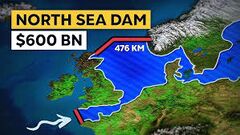North Sea
(Sea) | |
|---|---|
 $600bn Plan to Dam the North Sea[1] | |
| Locations | Northern Europe |
| East of the UK, North of the low countries, Northwest of Germany, West of Denmark | |
The North Sea lies between Great Britain, Denmark, Norway, Germany, the Netherlands, Belgium and France and connects to the Atlantic Ocean through the English Channel in the south and the Norwegian Sea in the north. It is more than 970 kilometres (600 miles) long and 580 kilometres (360 miles) wide, covering 570,000 square kilometres (220,000 square miles).[2]
Global importance
The North Sea has featured prominently in geopolitical and military affairs, particularly in Northern Europe, from the Middle Ages to the modern era. It was also important globally through the power northern Europeans projected worldwide from the Vikings' rise to the Hanseatic League, the Dutch Republic and the British each seeking to gain command of the North Sea and access to the world's markets and resources. As Germany's only outlet to the ocean, the North Sea was strategically important through both world wars.
Diverse geology
The coast has diverse geology and geography. In the north, deep fjords and sheer cliffs mark much of its Norwegian and Scottish coastlines respectively, whereas in the south, the coast consists mainly of sandy beaches, estuaries of long rivers and wide mudflats. Due to the dense population, heavy industrialisation, and intense use of the sea and the area surrounding it, various environmental issues affect the sea's ecosystems. Adverse environmental issues – commonly including overfishing, industrial and agricultural runoff, dredging, and dumping, among others – have led to several efforts to prevent degradation and to safeguard long-term economic benefits.[3]
OIl and gas
As early as 1859, North Sea oil was discovered in onshore areas and natural gas as early as 1910. Onshore resources, for example the North Sea gas K12-B field in the Netherlands continue to be exploited today.
Offshore test drilling began in 1966 and then, in 1969, Phillips Petroleum Company discovered the Ekofisk oil field distinguished by valuable, low-sulphur oil. Commercial exploitation began in 1971 with tankers and, after 1975, by a pipeline, first to Teesside, England and then, after 1977, also to Emden, Germany.
The exploitation of the North Sea oil reserves began just before the 1973 oil crisis, and the climb of international oil prices made the large investments needed for extraction much more attractive. The start in 1973 of the oil reserves by the UK allowed them to stop the declining position in international trade in 1974, and a huge increase after the discovery and exploitation of the huge oil field by Phillips group in 1977 as the Brae field.
Although the production costs are relatively high, the quality of the oil, the political stability of the region, and the proximity of important markets in western Europe have made the North Sea an important oil-producing region. The largest single humanitarian catastrophe in the North Sea oil industry was the destruction of the offshore oil platform Piper Alpha in 1988 in which 167 people lost their lives.
Besides the Ekofisk oil field, the Statfjord oil field is also notable as it was the cause of the first pipeline to span the Norwegian trench. The largest natural gas field in the North Sea, Troll gas field, lies in the Norwegian trench, dropping over 300 metres (980 ft), requiring the construction of the enormous Troll A platform to access it.
The price of Brent Crude, one of the first types of oil extracted from the North Sea is used today as a standard price for comparison for crude oil from the rest of the world. The North Sea contains western Europe's largest oil and natural gas reserves and is one of the world's key non-OPEC producing regions.[4]
In the UK sector of the North Sea, the oil industry invested £14.4 billion in 2013 and was on track to spend £13 billion in 2014. Industry body Oil & Gas UK put the decline down to rising costs, lower production, high tax rates, and less exploration.
In January 2018, The North Sea region contained 184 offshore rigs, which made it the region with the highest number of offshore rigs in the world at the time.
Event
| Event | Description |
|---|---|
| Alexander Kielland | Oil rig capsizing in 1980, the biggest disaster in Norwegian oil production. Theories of sabotage is a third rail subject. |
References
Wikipedia is not affiliated with Wikispooks. Original page source here